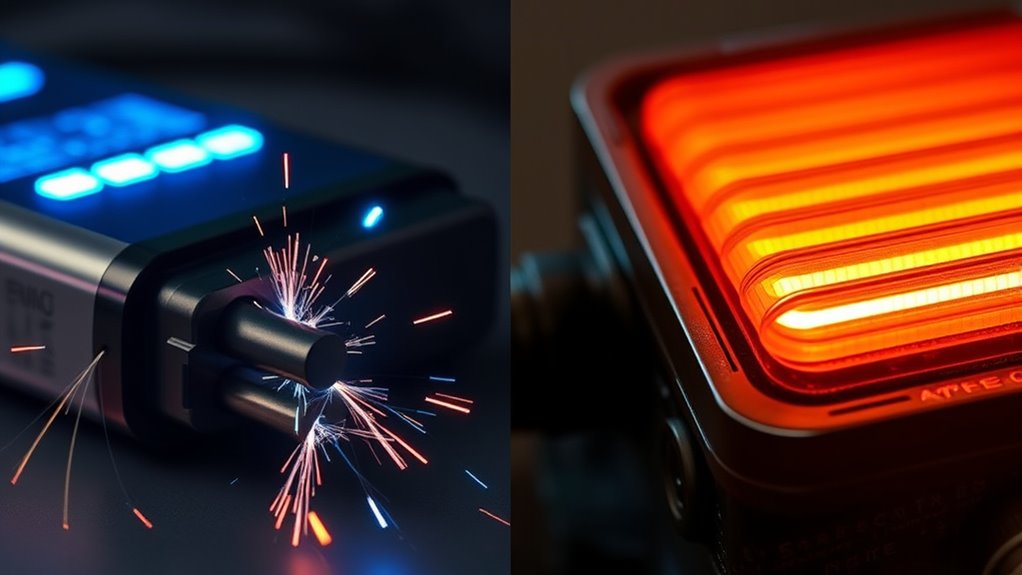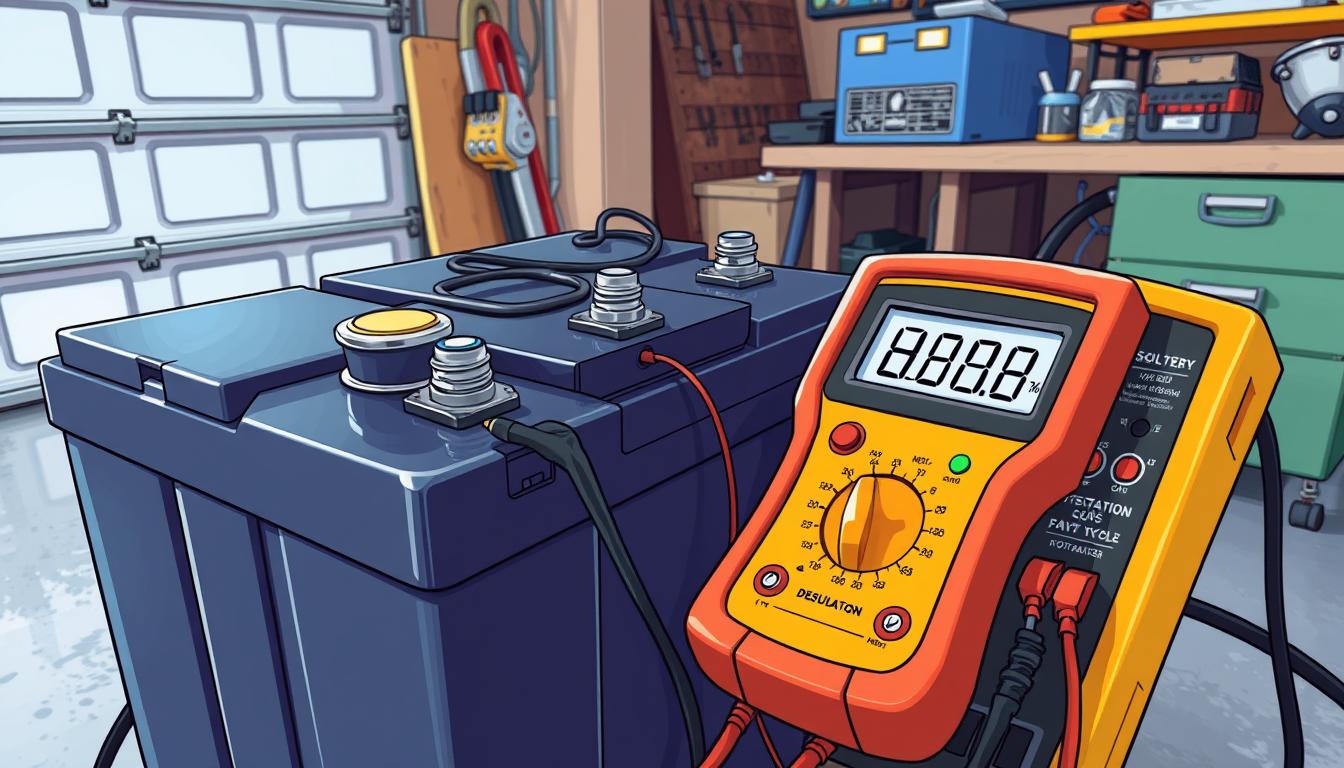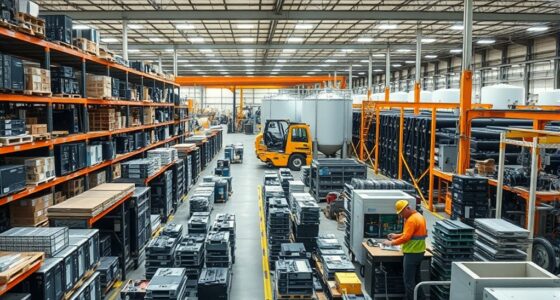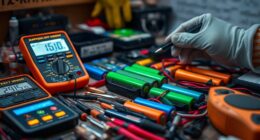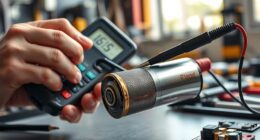Choosing between high- and low-frequency desulfation depends on your battery’s condition. High-frequency offers quick, aggressive crystal breakdown, making it great for severe sulfate buildup, but it requires careful handling to avoid damage. Low-frequency provides a gentler, safer approach for regular maintenance and moderate sulfation, though it takes longer. To get the best results and protect your battery’s lifespan, understanding their differences can really make a difference—stay tuned to learn more.
Key Takeaways
- High-frequency desulfation quickly breaks down stubborn sulfate crystals but risks internal damage if not properly controlled.
- Low-frequency methods offer a safer, gentler approach suitable for routine maintenance and moderate sulfate buildup.
- High-frequency techniques restore battery capacity faster but require expertise and precise calibration.
- Low-frequency signals minimize internal stress, making them ideal for home use and preventative care.
- The choice depends on sulfate severity: high-frequency for severe cases, low-frequency for moderate or preventive maintenance.
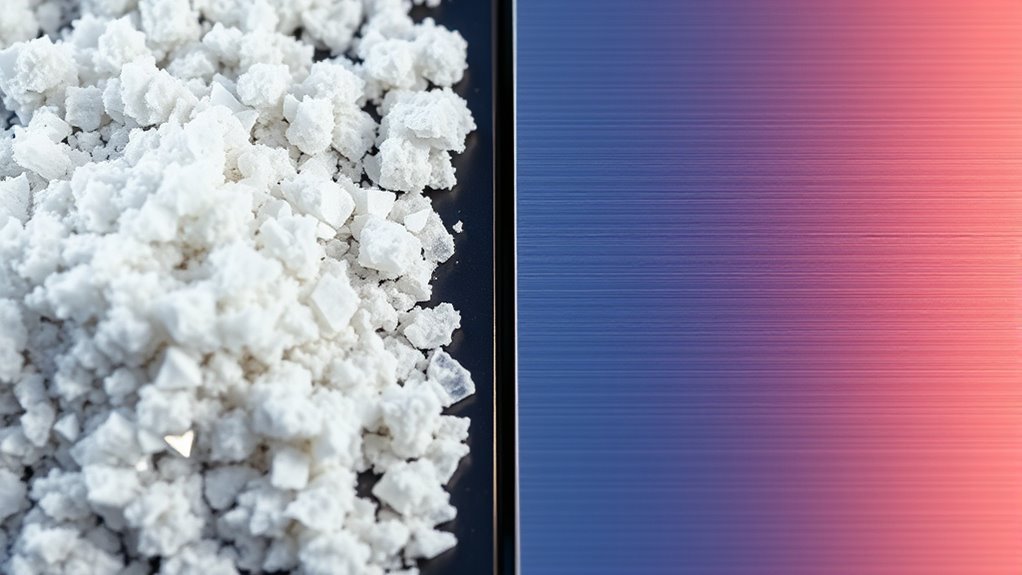
When it comes to restoring your vehicle’s battery performance, understanding the differences between high and low-frequency desulfation methods is essential. These techniques are crucial components of battery maintenance, especially if you want to prolong your battery’s lifespan and maintain reliable performance. The core difference lies in how each method applies electrical signals to break down lead sulfate crystals that form on the plates over time. High-frequency desulfation uses rapid, intense pulses to target stubborn deposits, while low-frequency approaches deliver gentler, more prolonged signals. Your choice impacts not only how effectively you remove sulfate buildup but also how safely you preserve the overall signal efficiency of your battery.
High-frequency desulfation tends to be more aggressive, making it suitable for batteries with severe sulfate accumulation. It works by sending quick, high-energy pulses that rapidly break apart the lead sulfate crystals. This method is often favored in professional or advanced battery maintenance setups because it can reduce sulfate deposits quickly and effectively. However, because of its intensity, high-frequency signals can sometimes stress the battery’s internal components if not properly controlled, potentially leading to damage if misused. The advantage, though, is that it can restore capacity faster, especially in cases where sulfate crystals have considerably compromised battery performance. Advanced techniques in high-frequency desulfation can maximize efficiency but require careful handling to avoid internal damage.
Low-frequency desulfation, on the other hand, employs slower, gentler signals that are less likely to cause internal stress. This approach is ideal for batteries that are moderately sulfated or for routine maintenance to prevent buildup. By applying low-frequency signals over a longer period, you allow the chemical processes within the battery to gradually dissolve sulfate crystals without risking internal damage. This makes it a safer option for maintaining signal efficiency over time, ensuring your battery remains dependable without pushing it to its limits. Additionally, low-frequency methods tend to be easier to control, making them suitable for home use or for those who prefer a cautious approach to battery maintenance. Proper calibration of these signals is essential to optimize performance and longevity.
Frequently Asked Questions
Can Desulfation Prevent Battery Replacement Entirely?
Desulfation can considerably extend your battery’s life, but it can’t prevent battery replacement entirely. Proper battery maintenance and using effective desulfation techniques help reduce sulfation buildup, delaying the need for replacements. Regularly monitoring your battery’s health and applying the right desulfation methods can keep it working efficiently longer. However, eventually, wear and age will necessitate a replacement, no matter how well you maintain it.
How Do Environmental Conditions Affect Desulfation Effectiveness?
Ever wondered how environmental conditions influence desulfation? Temperature impact plays a vital role—extreme heat or cold can hinder the process, making it less effective. Moisture influence is equally important; excess humidity can cause corrosion or short-circuiting, reducing success. You should guarantee your battery is in a stable environment, ideally dry and moderate in temperature, to maximize desulfation efficiency and prolong your battery’s life.
Are Certain Battery Types More Suited to High or Low-Frequency Desulfation?
You should consider your battery chemistry when choosing maintenance techniques, as some respond better to high-frequency desulfation, while others benefit from low-frequency approaches. Lead-acid batteries often require specific methods, whereas lithium-ion types may need different treatments. Recognizing your battery’s chemistry helps you select the most effective desulfation process, ensuring ideal performance and longevity. Always follow manufacturer guidelines to avoid damage and maximize the benefits of your chosen technique.
What Safety Precautions Are Necessary During Desulfation Procedures?
Imagine yourself handling a fragile, volatile thing — your battery. During desulfation, you must prioritize battery safety by wearing protective gear and working in a well-ventilated area. Watch out for chemical hazards, like acid splashes or fumes. Keep sparks away and avoid open flames. These precautions protect you from harm, ensuring safe procedures while maintaining your battery’s health. Safety first keeps both you and your equipment secure.
How Long Does It Typically Take to See Results From Desulfation?
You might see results from desulfation after several charging cycles, but it varies based on your battery’s condition. Stick to consistent maintenance routines, like regular charging and monitoring, to improve outcomes. Usually, you’ll notice increased performance within a few weeks of proper desulfation. Patience is key, as ongoing care helps prevent sulfation buildup and extends your battery’s lifespan over time.
Conclusion
Just like the legendary battle of Hercules and the Hydra, choosing between high- and low-frequency desulfation is about confronting the multi-headed challenge of battery maintenance. High frequency might be your swift hero, tackling stubborn deposits quickly, while low frequency offers a steady, thorough approach. Ultimately, the winner depends on your battery’s needs. Embrace the strategy that best suits your quest for longevity, and remember, with patience and the right technique, victory is within your grasp.

